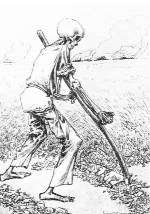Return to www.antimicrobe.org
The Influenza Pandemic of 1918
Molly Billings and Jeremy Schneider
The influenza pandemic of 1918-1919 killed somewhere between 20 and 40 million people: more people than the Great War, known today as World War I (WWI). It has been cited as the most devastating epidemic in recorded world history. More people died of influenza in a single year than in four-years of the Black Death Bubonic Plague from 1347 to 1351. Known as "Spanish Flu" or "La Grippe" the influenza of 1918-1919 was a global disaster.

The Grim Reaper by Louis Raemaeker
In the fall of 1918 the Great War in Europe was winding down and peace was on the horizon. The Americans had joined in the fight, bringing the Allies closer to victory against the Germans. Deep within the trenches these men lived through some of the most brutal conditions of life, which it seemed could not be any worse. Then, in pockets across the globe, something erupted that seemed as benign as the common cold. The influenza of that season, however, was far more than a cold. In the two years that this scourge ravaged the earth, a fifth of the world's population was infected. The flu was most deadly for people ages 20 to 40. This pattern of morbidity was unusual for influenza which is usually a killer of the elderly and young children. It infected 28% of all Americans (Tice). An estimated 675,000 Americans died of influenza during the pandemic, ten times as many as in the world war. Of the U.S. soldiers who died in Europe, half of them fell to the influenza virus and not to the enemy (Deseret News). An estimated 43,000 servicemen mobilized for WWI died of influenza (Crosby). 1918 would go down as unforgettable year of suffering and death and yet of peace. As noted in the Journal of the American Medical Association final edition of 1918:
"The 1918 has gone: a year momentous as the termination of the most cruel war in the annals of the human race; a year which marked, the end at least for a time, of man's destruction of man; unfortunately a year in which developed a most fatal infectious disease causing the death of hundreds of thousands of human beings. Medical science for four and one-half years devoted itself to putting men on the firing line and keeping them there. Now it must turn with its whole might to combating the greatest enemy of all--infectious disease," (12/28/1918).

An Emergency Hospital for Influenza Patients
The effect of the influenza epidemic was so severe that the average life span in the US was depressed by 10 years. The influenza virus had a profound virulence, with a mortality rate at 2.5% compared to the previous influenza epidemics, which were less than 0.1%. The death rates from influenza and pneumonia in 15 to 34-year-olds were 20 times higher in 1918 than in previous years (Taubenberger). People were struck with illness on the street and died rapid deaths. One anectode shared of 1918 was of four women playing bridge together late into the night. Overnight, three of the women died from influenza (Hoagg). Others told stories of people on their way to work suddenly developing the flu and dying within hours (Henig). One physician writes that patients with seemingly ordinary influenza would rapidly "develop the most viscous type of pneumonia that has ever been seen" and later when cyanosis appeared in the patients, "it is simply a struggle for air until they suffocate," (Grist, 1979). Another physician recalls that the influenza patients "died struggling to clear their airways of a blood-tinged froth that sometimes gushed from their nose and mouth," (Starr, 1976). The physicians of the time were helpless against this powerful agent of influenza. In 1918 children would skip rope to the rhyme (Crawford):
I had a little bird,
Its name was Enza.
I opened the window,
And in-flu-enza.
The influenza pandemic circled the globe. Most of humanity felt the effects of
this strain of the influenza virus. It spread following the path of its human
carriers, along trade routes and shipping lines.
 Outbreaks
swept through North America, Europe, Asia, Africa, Brazil and the South
Pacific (Taubenberger). In India the mortality rate was extremely high at
around 50 deaths from influenza per 1,000 people (Brown). World War I, with
its mass movements of men in armies and aboard ships, probably aided in its
rapid diffusion and attack.
Outbreaks
swept through North America, Europe, Asia, Africa, Brazil and the South
Pacific (Taubenberger). In India the mortality rate was extremely high at
around 50 deaths from influenza per 1,000 people (Brown). World War I, with
its mass movements of men in armies and aboard ships, probably aided in its
rapid diffusion and attack.